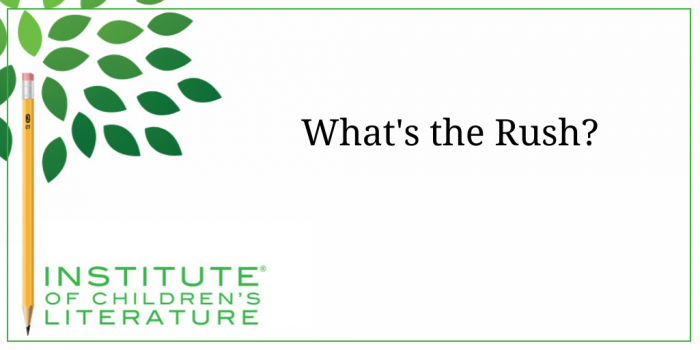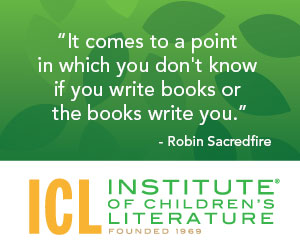1000 N. West Street #1200, Wilmington, DE 19801
© 2024 Direct Learning Systems, Inc. All rights reserved.

We teach our students how to write and get published!
View our Course Catalog >

In fact, the number one mistake writers make in the area of submitting their work is moving too fast and sending too soon. Slush piles are absolutely crammed with stories that are almost good or show real potential, but are just too far from finished to convince an editor to accept it.
When you submit a short story, article, poem or other piece to a magazine, you’re asking the editor to allot some of the magazine’s very limited space to that piece, with the understanding that readers will enjoy it.
When you submit a manuscript for a picture book, chapter book, or other to an agent, you’re asking that person to invest vast amounts of her time (potentially for free) with the understanding that the story is ready to be published.
And when you submit a manuscript to a book publisher, you’re literally asking them to invest thousands of dollars to make that manuscript into a book. And one thing has to be true before you’re going to find success in submissions: your story has to be ready (or as ready as you can possibly make it) for publication.
In a short story, your piece must have a strong character and clear plot that is engaging, organized, and clean. In a book, your piece must have those same things, but generally have to sustain them much longer and with more complexity. Every editor and agent knows that no manuscript is perfect. There are likely to be some typos (mine certainly have them) and there are likely to be a sentence or two (or maybe even more) that just doesn’t convey your point as clearly as it could. There are likely to be moments in the plot that aren’t quite as effective as they could be. In nonfiction, there may be another element the editor would like to see along with what you have. In other words, the editor doesn’t expect you to be perfect. But you should expect you to be as close to perfect as you’re capable of being. The manuscript shouldn’t give the impression that you really could have made it better if you’d just spent a bit more time.
Poetry Piffles
An interesting side note on perfection: the shorter the piece you’re sending, the closer to perfect it must be. A spring poem that is really good at the beginning but has a weak ending line just won’t make the cut. Now if the editor saw something she liked a lot about it, she may write back to you and tell you what the problem was (without making any promises about buying it if you fix it). And you may get a chance to work on it. Moments like that are wonderful gifts of the editor’s time and experience. But for every editor who does that, you’ll find others (or even the same editor on a different day) who just don’t have the time so they tsk over the near miss and move on to buy the other writer’s spring poem that is strong all the way to the end. It’s nothing personal. They just don’t have the time.
Picture Book Problems
This happens with picture books too. An author may have a wonderful rollicking sense of rhythm and a great main character, but no real plot. So the picture book is a series of loosely related events, or maybe it has a sense of plot but indulges in a line or two that really just seem to be there to make a rhyme work. What happens to that manuscript? It gets rejected. And most of the time, the writer is never told why. That’s really unfortunate because the reason why is often because you sent it too soon. You didn’t work long enough to make sure every line worked for the story and every incident came together to give us a sense of story progression. If there is any line in your picture book that gives you pause, that makes you wonder if it’s good enough, it might not be ready.
Here’s a tip: look at your piece and ask yourself, “Can I move around these incidents without really doing any harm to the piece? Will it still make sense if the third thing happens first and the first thing happens second?” If you can do that, then you don’t actually have a plot. You have a series of events. And unless your character driven picture book is very, very, very astoundingly clever and innovative, you really need a plot. A true plot moves in a forward direction that simply doesn’t work if you change the order of events.
Limp Endings
Another really common “too soon” problem is the weak ending. The writer comes up with a decent plot, gets going well, has a great main character and everything looks pretty good. But then it begins to weaken near the end. And the last paragraph, well, it feels a little limp. But you don’t really know what to do instead and you like the rest, so you send it out. You know what usually happens? It’s rejected. Weak endings will kill strong stories. It’s worth the time to find the good ending. Take a break from the story and go looking at endings for books or stories like yours. Read a bunch of just endings. Take notes on things that they have in common. Often during this research process, like magic, a new ending for your story will pop into your head. Your brain does its best creative work when you ask it to think about something else. So don’t send too early and let a weak ending kill your chances of publication.
By the way, fiction isn’t the only stuff that can suffer from weak endings. Nonfiction experiences this even more often. A writer comes up with a strong organization and a strong opening. And the piece looks really good, except that it eventually just stops. It’s as if the writer finished up the things he or she intended to present and just quit. So the piece doesn’t even have a weak ending. It has no ending. And it needs an ending. This is another time when researching strong endings in articles and nonfiction picture books can help you see a possible punching ending (even if it’s just one short, fun sentence) for your piece.
So as you prepare to submit your work this year, take care not to let your enthusiasm and impatience wreck your chances with a good story idea and an almost good execution. Ask yourself questions about your story or poem or article:
Keep asking fresh questions until you’re sure the piece is the best you can possibly make it. When you get the acceptance note, you’ll be so glad you didn’t rush.
With over 100 books in publication, Jan Fields writes both chapter books for children and mystery novels for adults. She’s also known for a variety of experiences teaching writing, from one session SCBWI events to lengthier Highlights Foundation workshops to these blog posts for the Institute of Children’s Literature. As a former ICL instructor, Jan enjoys equipping writers for success in whatever way she can.
1000 N. West Street #1200, Wilmington, DE 19801
© 2024 Direct Learning Systems, Inc. All rights reserved.
1000 N. West Street #1200, Wilmington, DE 19801
© 2024 Direct Learning Systems, Inc. All rights reserved.
1000 N. West Street #1200, Wilmington, DE 19801
© 2024 Direct Learning Systems, Inc. All rights reserved.
1000 N. West Street #1200, Wilmington, DE 19801
© 2025 Direct Learning Systems, Inc. All rights reserved.
1000 N. West Street #1200, Wilmington, DE 19801
©2025 Direct Learning Systems, Inc. All rights reserved. Privacy Policy.